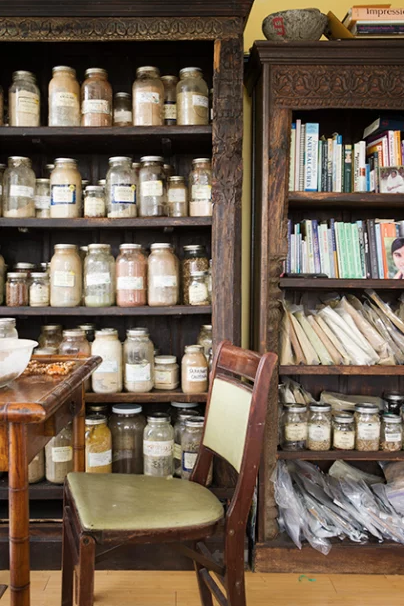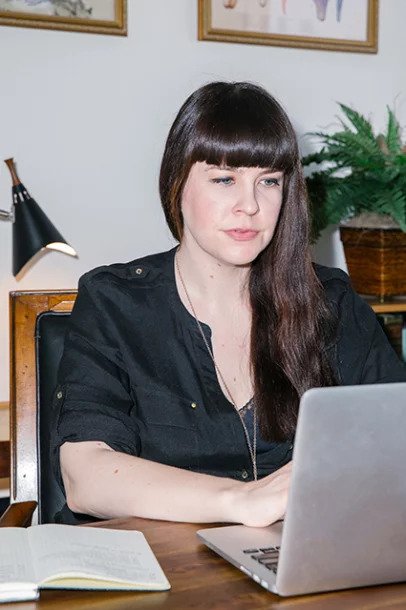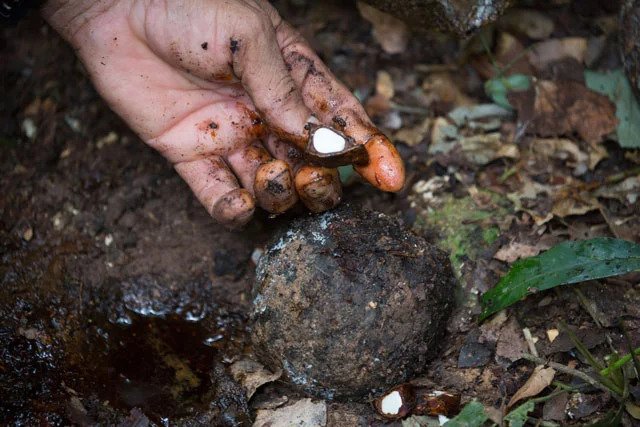“It’s deeply rejuvenating, but it’s also experiential…it’s a little bit difficult to articulate,” the woman across the table tells me between mouthfuls of dhal, a bland mung bean soup that we're both eating in preparation for what comes next. “Each time has been a different series of results and effects for me, but always an enormous amount of releasing: thoughts, feelings, patterns…”
I’m sitting in the kitchen of a house perched high on a cliff in the Pacific Palisades neighborhood of Los Angeles waiting to see Martha Soffer, an ayurvedic healer trusted by some of L.A.’s most notable current and former residents: Gwyneth Paltrow, Kate Hudson, Julia Roberts, Matt Damon, and Kourtney Kardashian, to name a few. Of course, celebrities are known to be fans of “woo-woo,” and I am not, so I’m impatiently waiting to get in, and out, so I can head back to the office.
Little did I know, I would not make it back to the R29 L.A. offices today.
THE COMMUNAL LUNCH TABLE. / PHOTO: COURTESY OF SURYA.
A Little Background
Ayurveda is a bit tough to describe. Basically, it’s an ancient Hindu system of wellness practices that originated in India between 5,000 and 10,000 years ago. (That's long before Jesus Christ and the pyramids, mind you.) It looks at the whole being — body, mind, and spirit — and calls upon nutrition, herbs, and treatments to achieve harmony and health through vigorous detoxification. The hallmark of this is called panchakarma, or PK, for short, which is essentially a lengthy mash-up of different smaller treatments, curated by your healer to achieve specific results. Ayurveda is thought to help everything from restless sleep to Parkinson's Disease, but more on that later.
A BLEND OF HERBS. / PHOTO: COURTESY OF SURYA.
Of all the things my lunchmate told me during the hour I waited for my treatment, the most necessary to share is this: "The more I learn about ayurveda, the more I realize I don't know anything — and I know a lot!" she told me. Of course, like fashion, food, and popular culture, what’s old almost always becomes new again, which is exactly why I am nibbling on the recommended pre-treatment lunch of dhal, steamed rice, and vegetables with women who have just come out of morning treatments, and those waiting to go into the afternoon ones. And then my name was called.
...THE WOMEN BEGIN TO BLOT AND WIPE THE MILK OVER MY ENTIRE BODY...
The Consultation
Once inside the master bedroom, I am told to undress and lie on a table draped with a white sheet. There are steps up to table, and crystals artfully positioned underneath it. I quickly learn this is no luxury massage: No lights will be dimmed, no terry cloth robe will be provided, and I need to get over my fear of being buck naked in front of strangers — or I will not be healed today.
Once on the table, I'm covered with a sheet, and Soffer enters the room to take my pulse. With one hand firmly on my wrist, she asks me a series of questions about my health, zeroing in on queries about my skin and joints. I tell her I get hives and dry skin on occasion but have no joint issues. She continues to press, but I assure her my joints are fine. Knees? All good, I say. Hips? Pain-free, I assure her. She gives me a look of disbelief and goes to finish preparing my treatments in the kitchen.
Later, I learn that she's holding my pulse to determine which of three doshas — broad categories that describe your body's humor, or temperament — I most closely align with. She tells me that a Vata's pulse jumps like a frog, a Pitta's swims like a swan, and a Kapha's slithers like a snake. Vata people tend to have trouble gaining weight and are often cold and stressed; Pittas neither gain nor lose weight easily, can have high blood pressure, and are highly reactive emotionally; and Kaphas have trouble losing weight and are generally more laid-back. I'm deemed a Pitta and my treatment will include cooling herbs, milk, and brown rice to help "calm my insides," which will, in turn, help my redness and hives.
A CUSTOME MIXTUR EOF HERBS BEING LOADED INTO A BOLSA. / PHOTO: COURTESY OF SURYA.
Treatment 1: The Oily One
First up is a vat of oil cooked the night before with a blend of herbs to help the health concerns I reported when I made the appointment: stress, trouble sleeping, and more stress. The first woman (there are always two working on me) fashions a small towel into a loincloth of sorts, places it on my nether regions, and begins by drenching my hair and scalp with the hot oil. Then, in unison, they pour and massage more oil over my entire body. Breasts, butt, thighs — it's all being oiled, with each woman doing mirror movements on either side of my body the entire time. The oil has a rich, earthy scent that is unpleasant but not intolerable, and it's a few degrees warmer than what would be considered comfortable. Unlike a massage, there is no pressure; they're simply rubbing it in, and pouring more and more oil until the sheet I am laying on is drenched and I am laying in a hot, oily pool. This goes on for about an hour, after which I am wrapped in a clean sheet while they (thankfully) change the sheets on the bed.
OIL LACED WITH HERBS. PHOTO: COURTESY OF SURYA.
Treatment 2: The Milky One
When I return from the restroom, I lie back on the bed and I get another hand-towel loincloth. Using bolsas (small cloth bags full of herbs and, for my treatment, brown rice) dipped in hot, raw milk, the women begin to blot and wipe the milk over my entire body. As I lie there, I can feel the milk begin to thicken and turn sticky. I take a moment to peek from under my eye mask, and the liquid saturating my new sheet is brown and slightly chunky. Just like the oil, it begins to pool around my body. This goes on for another hour or so. At this point, I am ready to go home. Like, now. But I grin and bear it and am relieved when I am told I can rinse the clumpy hot milk from my body before my next treatment. I am led back to the bathroom, where I fiddle with the shower until I manage to get a tolerable water temperature. There are no bath towels, so I grab a loincloth-size hand towel and return to the room.
A TYPICAL TREATMENT USING BOLSAS FILLED OF HERBS. / PHOTO: COURTESY OF SURYA.
Treatment 3 : The Drippy One
It's nearing 4 p.m. (I arrived at 1 p.m.), but I agree to the last treatment, a jug that drips a steady stream of liquid directly onto the center of your forehead for around 25 minutes. It's called shirodhara and is said to work wonders on the nervous system. I consider myself very lucky that Soffer has selected coconut water for mine (hot oil is another common option, and I don't think I could have taken more oil at this point). At first it's jarring. Between the proximity to my eyes and the odd sensation, my nerves are going haywire, but eventually they calm. I never truly relaxed during it — Soffer told me that takes some practice — and by the time the water stopped 25 minutes later, I am one oily foot out the door. After a second shower, I have officially finished my first round of ayurveda, and never before have I been so relieved to be done with any journalistic assignment. (For the record, it took a second shower at home to remove all the oil from my hair and a few more to lift the scent from my skin.)
Astrology, yoga, lifestyle, food, treatments...it's a complete system of health.
MARTHA SOFFER
The Day After
A few days later, I caught up with Soffer on the phone, where she explained the doshas, the treatments I received, and a little bit about her background. Sure, she's an alternative healer to the stars, but her start wasn't unusual. In the mid-'90s, she was recently dumped and totally despondent, so she left Colombia and ventured to the States for higher education. After working on her ESL at Maharishi School of the Age of Enlightenment (Soffer is also an expert in transcendental meditation), she went on to study alternative medicine. Shortly after, she became in demand for her unique skill in the practice of ayurveda and, less than a decade later, she's leading a resurgence of the ancient practice. She was one of the first to practice in L.A.; now there are dozens popping up in affluent neighborhoods including Beverly Hills and West Hollywood. After all, the treatments aren't cheap. Soffer charges between $195 and $550 per day, and you're encouraged to go for a series lasting between three and 21 days for optimal effects.
A BOLSA READY FOR THE TREATMENT. / PHOTO: COURTESY OF SURYA.
Soffer has no shortage of information on the subject, but as she continued to touch on the many layers of the ideology on our phone call, I am reminded of the quote my lunch buddy told me: The more you learn, the less you know. Which is exactly how I am feeling. Ayurveda is both complicated and simple, and completely up to interpretation. After all, it's been around far longer than recorded history, so the original manual isn't printed in a textbook. According to Soffer, "Ayurveda is about life." She continues, "It uses astrology, yoga, lifestyle, food, treatments…it's a complete system of health."
It's no secret that the Western medical community is split on the topic. It's not difficult to find a M.D. who practices ayurveda as part of an integrative medical approach (the combination of conventional and alternative medicine), but then again, it's far easier to find one that dismisses Eastern practices like this. I say, if rubbing milk on your body floats your boat, go for it! Your health and well-being is what you make it. But I'll probably keep my dairy in my coffee.

































